
Afghanistan is a multiethnic and mostly tribal society. The population of the country consists of numerous ethnolinguistic groups: mainly the Pashtun, Tajik, Hazara, and Uzbek, as well as the minorities of Aimaq, Turkmen, Baloch, Pashai, Nuristani, Gujjar, Brahui, Qizilbash, Pamiri, Kyrgyz, Moghol, and others. Altogether they make up the Afghan people.
The former Afghan National Anthem and the Afghan Constitution (before 2021) each mention fourteen of them.
| Part of a series on the |
| Culture of Afghanistan |
|---|
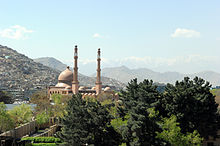 |
| History |
| People |
| Languages |
| Traditions |
| Mythology |
| Cuisine |
| Festivals |
| Religion |
| Art |
| Literature |
| Music and performing arts |
| Media |
| Sport |
| Monuments |
| Symbols |
Fertility rate by Ethnic origins
| Year | Afghanistan (Overall) | Pashtuns | Tajiks | Hazaras | Uzbeks | Turkmens | Localized Arabs | Indo-Aryans (Pashayis, Nuristanis, etc.) | Localized Soviets | Others |
|---|---|---|---|---|---|---|---|---|---|---|
| 1950 | 7.25 | 8.30 | 7.55 | 7.85 | 7.70 | 7.65 | 6.80 | 7.40 | - | 4.10 |
| 1960 | 7.28 |
8.28 |
7.48 |
7.72 |
7.64 |
7.62 |
6.75 |
7.35 |
- | 4.00 |
| 1970 | 7.40 |
8.25 |
7.52 |
7.81 |
7.68 |
7.66 |
6.80 |
7.42 |
- | 3.95 |
| 1980 | 7.64 |
8.35 |
7.60 |
7.88 |
7.74 |
7.73 |
6.90 |
7.50 |
- | 3.85 |
| 1990 | 7.58 |
8.20 |
7.58 |
7.72 |
7.66 |
7.69 |
6.82 |
7.45 |
2.30 |
3.80 |
| 1995 | 7.77 |
8.32 |
7.66 |
7.85 |
7.75 |
7.78 |
6.88 |
7.58 |
2.95 |
3.77 |
| 2000 | 7.57 |
7.95 |
7.38 |
7.50 |
7.40 |
7.36 |
6.65 |
7.32 |
3.25 |
3.62 |
| 2010 | 5.12 |
6.45 |
5.15 |
5.55 |
5.45 |
5.40 |
4.80 |
5.20 |
3.10 |
3.30 |
| 2015 | 5.25 |
6.60 |
5.25 |
5.60 |
5.50 |
5.45 |
4.30 |
5.30 |
2.90 |
2.80 |
| 2023 | 5.40 |
6.75 |
5.35 |
5.80 |
5.70 |
5.60 |
4.28 |
5.45 |
2.85 |
2.77 |
National identity
Further information: Afghans, Afghan (ethnonym), Afghan identity card, and Name of AfghanistanThe term "Afghan" is synonymous with the ethnonym "Pashtun", but in modern times the term became the national identity of the people, who live in Afghanistan.
The national culture of Afghanistan is not uniform, at the same time, the various ethnic groups have no clear boundaries between each other and there is much overlap. Additionally, ethnic groups are not racially homogenous. Ethnic groups in Afghanistan have adopted traditions and celebrations from each other and all share a similar culture. For example, Nauruz is a New Year festival celebrated by various ethnic groups in Afghanistan.
Larger ethnic groups
Pashtuns
Further information: Pashtuns, Pashtun tribes, and Theories of Pashtun origin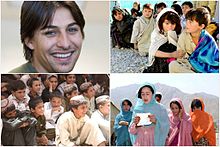
The Pashtuns make up the largest ethnic group in Afghanistan. The exact numbers vary; according to the Library of Congress Country Studies' estimate of 1996, Pashtuns made up 40% of Afghanistan's population. More recent estimates vary between 42% in 2013 and 52.4% in 2023. The majority of Pashtuns practice Sunni Islam. After the rise of the Hotaki dynasty in 1709 and the Durrani Empire in 1747, Pashtuns expanded by forming communities in what is now Afghanistan and Pakistan.
There are conflicting theories about the origin of the Pashtun people, both among historians and the Pashtun themselves. A variety of ancient groups with eponyms similar to Pukhtun have been hypothesized as possible ancestors of modern Pashtuns. Since the 3rd century AD and onward they are mostly referred to by the ethnonym "Afghan", a name believed to be given to them by neighboring Persian people. Some believe that ethnic Afghan is an adaptation of the Prakrit ethnonym Avagana, attested in the 6th century CE. It was used to refer to a common legendary ancestor known as "Afghana", asserted to be grandson of King Saul of Israel.
Tajik
Further information: Tajiks, Farsiwan, and List of Tajik people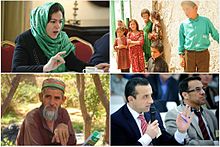
The Tajiks are a Persian-speaking ethnic group. Historically, Tajiks were not considered to be a distinct ethnic group but rather a collection of several sedentary Sunni Muslims who spoke a Persian dialect as their mother tongue. The Tajiks usually refer to themselves by the region, province, city, town, or village that they are from rather than by tribes, for example: Badakhshi, Baghlani, Mazari, Panjsheri, Kabuli, Herati, Kohistani, etc. Alternative names for the Tajiks are Fārsīwān (Persian-speaker) and historically Dīhgān (cf. Tajik: Деҳқон, romanized: Dehqon, literally "farmer or settled villager", in a wider sense "settled" in contrast to "nomadic"). Tajiks are mainly descended from Bactrians and Sogdians, and are native to Northern Afghanistan, as they have continually inhabited the region for many millennia.
Tajiks are considered the second-largest group in Afghanistan. While it is estimated that they make up about 37% of the population of Afghanistan in 2019; they made up 25.3% of Afghanistan's population in 1996, and the Encyclopædia Britannica explains that by the early 21st century they constituted about one-fifth (i. e. 20%) of the population. It is important to note that all of these numbers are unreliable as there is no official census in Afghanistan.
Hazara
Further information: Hazaras, List of Hazara tribes, Aimaq Hazara, and List of Hazara people
The Hazaras are one of the largest ethnic groups in Afghanistan and a principal component to their population. They reside in all parts of Afghanistan, mainly in the Hazarajat region in central Afghanistan. Linguistically the Hazaras speak the Dari and Hazaragi dialects of the Persian language. Dari is the official language of Afghanistan and Hazaragi is closely related to Dari. They practice Islam, mostly Shi'a, with a significant Sunni minority, and some Isma'ili. According to Library of Congress Country Studies in 1996, Hazaras made up 18% of country's population.
Some notable Hazaras of Afghanistan include: Abdul Ali Mazari, Commander Shafi Hazara, Sadiqi Nili, Ismael Balkhi, Muhammad Ibrahim Khan, Sultan Ali Keshtmand, Abdul Wahed Sarābi, Karim Khalili, Habiba Sarābi, Sarwar Danish, Sima Samar, Ramazan Bashardost, Muhammad Arif Shah Jahan, Abdul Haq Shafaq, Sayed Anwar Rahmati, Qurban Ali Urozgani, Azra Jafari, Ahmad Shah Ramazan, Muhammad Mohaqiq, Ahmad Behzad, Nasrullah Sadiqi Zada Nili, Abbas Noyan, Fahim Hashimi, Rohullah Nikpai, Hamid Rahimi, Mohammad Ebrahim Khedri, Wakil Hussain Allahdad, and Dawood Sarkhosh.
Uzbek
Further information: Uzbeks, List of Uzbeks, and Afghan Turkestan
The Uzbeks are one of the main Turkic ethnic group in Afghanistan, whose native territory is in the northern regions of the country. Most likely the Uzbeks migrated with a wave of Turkic invaders and intermingled with local Iranic tribes over time to become the ethnic group they are today. The Uzbeks of Afghanistan are predominantly Sunni Muslims and fluent in Southern Uzbek. Uzbeks living in Afghanistan were estimated in the 1990s at approximately 1.3 million but are believed to be 2 million in 2011.
Some notable Uzbeks of Afghanistan include: Azad Beg, Alhaj Mutalib Baig, Abdul Rashid Dostum, Suraya Dalil, Husn Banu Ghazanfar, Delbar Nazari, Abdul Rauf Ibrahimi, Muhammad Yunus Nawandish, Sherkhan Farnood, Abdul Majid Rouzi, Rasul Pahlawan, and Abdul Malik Pahlawan.
Smaller ethnic groups
Aimaq
Further information: Aimaq people and Aimaq HazaraThe Aimaqs, Aimaq meaning "tribe" or "group of tribes" in Turkic-Mongolic (Oymaq), is not an ethnic denomination, but differentiates semi-nomadic herders and agricultural tribal groups of various ethnic origins including the Hazara, Tajik, and others, that were formed in the sixteenth and seventeenth centuries. They live among non-tribal people in the central and western highlands of Afghanistan, especially in Badghis, Ghor, and Herat provinces. They practice Sunni Islam, speak the Dari and Aimaqi dialects of Persian, and refer to themselves with tribal designations.
Turkmen
Further information: Turkmens, Afghan Turkmens, Turkmen tribes, and Afghan Turkestan
The Turkmens are a smaller Turkic-speaking ethnic group in Afghanistan. They are predominantly Sunni Muslims, and their origins are similar to that of the Uzbeks. Unlike the Uzbeks, however, the Turkmens are traditionally a nomadic people (though they were forced to abandon this way of life in Turkmenistan itself under Soviet rule). In the 1990s their number was put at around 200,000.
Baloch
Further information: Baloch of Afghanistan, Baloch people, and List of Baloch tribes
The Baloch people are speakers of the Balochi language who are mostly found in and around the Balochistan region of Afghanistan. In the 1990s their number figure was put at 100,000 but they are around 200,000 today. Mainly pastoral and desert dwellers, the Baloch people of Afghanistan are predominantly Sunni Muslims. Abdul Karim Brahui the former Governor of Nimruz province, is an ethnic Baloch.
Pashayi
Further information: Pashayi people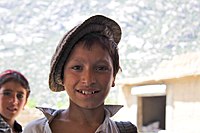
The Pashayi are an Indo-Aryan ethnolinguistic group living primarily in eastern Afghanistan. They are mainly concentrated in the northern parts of Laghman and Nangarhar, also parts of Kunar, Kapisa, Parwan, Nuristan, and a bit of Panjshir. Their total population is estimated to be 400,000.
Nuristani
Further information: Nuristanis, Kalash people, and Nuristani languages
The Nuristanis are an Indo-Iranian people, representing a third independent branch of the Aryan peoples (Indo-Aryan, Iranian and Nuristani), who live in isolated regions of northeastern Afghanistan as well as across the border in the district of Chitral in Pakistan. They speak a variety of Nuristani languages. Better known historically as the Kafirs of what was once known as Kafiristan (land of pagans). In the mid-1890s, after the establishment of the Durand Line when Afghanistan reached an agreement on various frontier areas to the British Empire for a period of time, Abdur Rahman Khan conducted a military campaign in Kafiristan and followed up his conquest with forced conversion of the Kafirs to Islam; the region thenceforth being known as Nuristan, the "Land of Light". Before their conversion, the Nuristanis practiced a form of ancient Hinduism. Non-Muslim religious practices endure in Nuristan today to some degree as folk customs. In their native rural areas, they are often farmers, herders, and dairymen. The population in the 1990s was estimated at 125,000 by some; the Nuristani prefer a figure of 300,000.
The Nuristan region has been a prominent location for war scenes that have led to the death of many indigenous Nuristanis. Nuristan has also received abundance of settlers from the surrounding Afghanistan regions due to the borderline vacant location.
Pamiri
Further information: PamirisPamiris are people who speak the Pamiri languages. Pamiris share close linguistic, cultural and religious ties with the people in Badakhshan Province in Afghanistan, the Sarikoli speakers in Taxkorgan Tajik Autonomous County in Xinjiang Province in China and the Wakhi speakers in Afghanistan and Pakistan. They practice predominantly Nizari Isma'ili Shia Islam. The Pamiri people have their own distinctive styles of dress, which can differentiate one community from the next. The styles of hats are especially varied: one can spot someone from the Wakhan, as opposed to from Ruhshon or Shugnon valleys, based solely on headwear.
Kurd
Further information: Kurds and Kurdish tribesKurds have been coming to Afghanistan at different times and lived there. Another large wave of Kurdish migration into Afghanistan was the continuation of their migration from Iranian Kurdistan to greater Khorasan during the Afsharid dynasty. Two main groups formed Nader Shah's army. The first was a group of Shahsevan Turks who were in charge of warfare and combat, and the second was a group of Kurds who served as a backup for Nader's army. Although the majority of Afghan Kurds are descendants from the Kurds brought to fight the Mongols, or the descendants of the Kurds who migrated to Afghanistan, or the descendants of Kurds loyal to Nader Shah, a significant amount came in the 1980s to fight in the Soviet–Afghan War to fight against the Soviets. Afghan Kurds today are mostly assimilated, yet acknowledge that they are Kurds, most of them speak Dari as their first language, and only a few Kurdish speakers exist among them. They follow Sunni Islam and mainly live in the cities of Herat, Ghazni, Mazar-i-Sharif, and Kabul. Kurds in Afghanistan number 312,000 people.
Gujar
Further information: Gujars, Gurjar clans, and List of GurjarsThe Gujar people are a tribal group who have lived in Afghanistan for centuries. According to the Afghanistan news agency Pajwok Afghan News, there are currently an estimated 1.5 million Gujar people residing in the country. The Gujar people are predominantly inhabit in the northeastern regions of Afghanistan, including Kapisa, Baghlan, Balkh, Kunduz, Takhar, Badakhshan, Nuristan, Laghman, Nangarhar, and Khost. They have a distinct culture and way of life.
The old Afghanistan constitution recognised 14 ethnic groups officially with the Gujar ethnic group being one of them. Many Gujar tribal people in Afghanistan are deprived of their rights and their living conditions are poor. The Gujar in Afghanistan have sometimes been internally displaced in the past by illegal militias, during 2018 around 200 Gujar families were displaced from their homes in Farkhar district in Takhar province. During the corona virus pandemic, the Gujar people in the northeastern province of Badakhshan used Andak meat to treat the corona virus, due to lack of clinics and other health facilities in their areas. The Gujar Tribe Council deemed the meat of the Andak animal as Haram, however many Gujar people in the area said they had no choice.
In the past Gujar tribal leaders have met with the previous President of Afghanistan, Hamid Karzai. The Gujar elders demanded schools and hospitals to be built in their areas and the Afghan government give scholarships to Gujar students to study abroad.
Kyrgyz
Further information: Kyrgyz peopleThe Kyrgyz population of Afghanistan was 1,130 in 2003, all from the eastern Wakhan District in the Badakhshan Province of northeastern Afghanistan. They live a nomadic lifestyle.
Others
More small groups include the Moghol, Ormur, Wakhi, Sindhi, Hindkowan, Punjabi, Peripatetic groups, and others.
In September 2021, Zablon Simintov left Afghanistan, and thus the Afghan Jewry came to its end.
Distribution
Of the major ethnicities, the geographic distribution can be varied. Still, there are generally certain regions where one of the ethnic groups tend to dominate the population. Pashtuns are highly concentrated in southern Afghanistan and parts of the east, but nevertheless large minorities exist elsewhere. Tajiks are highly concentrated in the north-east but also form large communities elsewhere such as in western Afghanistan. Hazaras tend to be mostly concentrated in the wider "Hazarajat" region of central Afghanistan, while Uzbeks are densely populated in the north. Some places are very diverse: the city of Kabul, for example, has been considered a "melting pot" where large populations of the major ethnic groups reside, albeit traditionally with a distinct "Kabuli" identity. The provinces of Ghazni, Kunduz, Kabul, and Jowzjan are noted for remarkable ethnic diversity.
Ethnic composition

The population of Afghanistan was estimated in 2023 at 41.6 million. An additional 3 million or so Afghans are temporarily housed in neighboring Pakistan and Iran, most of whom were born and raised in those two countries. This makes the total Afghan population around 44.6 million, and its current growth rate is 2.33%.
While there are no reliable statistics post-2004, an approximate distribution of the ethnic groups is shown in the chart below:
| Ethnic group | Image | 2023 estimate based on native mother tongue | Pre-2021 estimates |
Pre-2004 estimates |
Pre-1992 estimates |
Pre-1973 estimates |
|---|---|---|---|---|---|---|
| Pashtun | 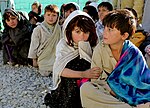
|
52.4% | 37–60% ≈48.5% |
38–62% ≈50% |
50–70% ≈60% |
55–60% ≈57.5% |
| Tajik | 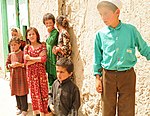
|
32.1% | 20–39% ≈29.5% |
12–28% ≈20% |
20–35% ≈27.5% |
20–30% ≈25% |
| Hazara | 
|
6–13% ≈9.5% |
7–19% ≈13% |
5–10% ≈7.5% |
3–7% ≈5% | |
| Uzbek | 
|
8.8% | 5–9% ≈7% |
6–14% ≈10% |
5–10% ≈7.5% |
3–8% ≈5.5% |
| Aimaq | – | 0–4% ≈2% |
– | – | – | |
| Turkmen | 1.9% | 1–3% ≈2% |
2–2.5% ≈2.25% |
– | – | |
| Baloch | 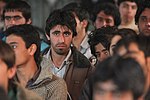
|
0.9% | 0–3% ≈1.5% |
– | – | – |
| Others (Pashai, Nuristani, Brahui, Qizilbash, Pamiri, Gujjar, and etc) | 
|
3.9% | 0–4% ≈2% |
1–12% ≈6.5% |
0–5% ≈2.5% |
0–4% ≈2% |
- This number represents Dari Persian native speakers including Tajiks, Hazaras, Aimaqs, Qizilbash, and other smaller ethnicities.
The recent estimate in the above chart is somewhat supported by the below national opinion polls, which were aimed at knowing how a group of about 804 to 8,706 local residents in Afghanistan felt about the current war, political situation, as well as the economic and social issues affecting their daily lives. Ten surveys were conducted between 2004 and 2015 by the Asia Foundation (a sample is shown in the table below; the survey in 2015 did not contain information on the ethnicity of the participants) and one between 2004 and 2009 by a combined effort of the broadcasting companies NBC News, BBC, and ARD.
| Ethnic group | "Afghanistan: Where Things Stand" (2004) "A survey of the Afghan people" (2004) |
"Afghanistan: Where Things Stand" (2005) | "Afghanistan: Where Things Stand" (2006) | "Afghanistan: Where Things Stand" (2007) | "A survey of the Afghan people" (2007) | "Afghanistan: Where Things Stand" (2009) | "A survey of the Afghan people" (2012) | "A survey of the Afghan people" (2014) | "A survey of the Afghan people" (2018) | "A survey of the Afghan people" (2019) |
|---|---|---|---|---|---|---|---|---|---|---|
| Pashtun | 46% | 40% | 42% | 38% | 40.1% | 40% | 40% | 40% | 37% | 39% |
| Tajik | 39% | 37% | 37% | 38% | 35.1% | 37% | 33% | 36% | 37% | 37% |
| Hazara | 6% | 13% | 12% | 6% | 10.0% | 11% | 11% | 10% | 10% | 11% |
| Uzbek | 6% | 6% | 5% | 6% | 8.1% | 7% | 9% | 8% | 9% | 8% |
| Aimaq | 0% | 0% | 0% | 0% | 0.8% | 0% | 1% | 1% | 1% | <0.5% |
| Turkmen | 1% | 1% | 3% | 2% | 3.1% | 2% | 2% | 2% | 2% | 2% |
| Baloch | 0% | 0% | 0% | 3% | 0.7% | 1% | 1% | 1% | 1% | <0.5% |
| Others (Pashayi, Nuristani, Kurdish, Qizilbash) | 3% | 3% | 1% | 5% | 2.1% | 3% | 3% | 2% | 2% | 3% |
| Don't know | -% | -% | -% | -% | -% | -% | -% | -% | 1% | -% |
What is noticeable is that the percentage of Tajiks is noticeably higher across the board in these polls in comparison to the estimations of The World Factbook, World Data etc., while the number of Pashtuns and Aimaqs tends to get underrepresented.
See also
References
- Iwamura, Shinobu (April 1956). "Hunting for the Génghis Khanid Mongols in Afghanistan". Japan Quarterly. 3 (2): 213. ProQuest 1304280677.
- "Mongolian".
- "Mongolian".
- "Mongolian languages summary | Britannica".
- "Article Four of the Constitution of Afghanistan". Archived from the original on 28 October 2013. Retrieved 23 May 2017.
The nation of Afghanistan is comprised of the following ethnic groups: Pashtun, Tajik, Hazara, Uzbak, Turkman, Baluch, Pashai, Nuristani, Aimaq, Qirghiz, Qizilbash, Gujur, Brahwui and others.
- Demographic and Health Surveys Program (DHS)
- "Afghanistan MICS 2022-23" (PDF). mics.unicef.org. Retrieved 30 November 2024.
- ^ Kieffer, Ch. M. "Afghan". Encyclopædia Iranica. Archived from the original on 16 November 2013.
From a more limited, ethnological point of view, "Afḡān" is the term by which the Persian-speakers of Afghanistan (and the non-Paṧtō-speaking ethnic groups generally) designate the Paṧtūn. The equation Afghans = Paṧtūn has been propagated all the more, both in and beyond Afghanistan, because the Paṧtūn tribal confederation is by far the most important in the country, numerically and politically.
- ^ "ABC NEWS/BBC/ARD poll - Afghanistan: Where Things Stand" (PDF). ABC News. Kabul, Afghanistan. pp. 38–40. Archived (PDF) from the original on 28 June 2011. Retrieved 29 October 2010.
- "Afghanistan – Non-Muslims". countrystudies.us. Archived from the original on 3 November 2016. Retrieved 27 April 2018.
- ^ Afghanistan in 2018. A Survey of the Afghan People (PDF). The Asia Foundation. 2018. p. 283. Archived from the original (PDF) on 15 November 2012.
- ^ "The World Factbook". cia.gov. Archived from the original on 14 October 2013. Retrieved 11 January 2022.
- ^ "Afghanistan: Country data and statistics". Archived from the original on 4 January 2024.
- ^ See:
- "People and Society :: 33,332,025 (2016 est.)". The World Factbook. www.cia.gov. Archived from the original on 7 June 2017. Retrieved 23 May 2017.
- "Ethnic groups". BBC News. Archived from the original on 1 November 2013. Retrieved 7 June 2013.
Pashtun: Estimated to be in excess of 45% of the population, the Pashtuns have been the most dominant ethnic group in Afghanistan.
- Janda, Kenneth; Jeffrey M. Berry; Jerry Goldman (2008). The Challenge of Democracy: Government in America (9 ed.). Cengage Learning. p. 46. ISBN 978-0-618-81017-8. Retrieved 22 August 2010.
- "Afghanistan's complex ethnic patchwork". The Asian Wall Street Journal. Tehran Times. 10 March 2011. Archived from the original on 20 November 2012. Retrieved 20 April 2012.
- "About Afghanistan – Ethnic Divisions". Archived from the original on 17 September 2010. Retrieved 24 September 2010.
- Christensen, Asger (1995). Aiding Afghanistan: the background and prospects for reconstruction in a fragmented society. NIAS Press. p. 46. ISBN 87-87062-44-5. Retrieved 24 September 2010.
- Congressional Record. Government Printing Office. 1949. p. 10088. ISBN 9780160118449. Retrieved 24 September 2010.
- Taylor, William J. Jr.; Abraham Kim (2000). Asian Security to the Year 2000. DIANE Publishing. p. 58. ISBN 1-4289-1368-8. Retrieved 24 September 2010.
- "The ethnic composition of Afghanistan in different sources". Archived from the original on 5 February 2012. Retrieved 22 April 2012.
- "Ethnic map of Afghanistan" (PDF). Thomas Gouttierre, Center For Afghanistan Studies, University of Nebraska at Omaha; Matthew S. Baker, Stratfor. National Geographic Society. 2003. Archived from the original (PDF) on 15 July 2011. Retrieved 24 October 2010.
- "Afghan and Afghanistan". Abdul Hai Habibi. alamahabibi.com. 1969. Archived from the original on 7 July 2011. Retrieved 24 October 2010.
- "Pashtun". Encyclopædia Britannica. Archived from the original on 30 October 2013. Retrieved 21 March 2011.
- C.E. Bosworth; B.G. Fragner (1999). "TĀDJĪK". Encyclopaedia of Islam (CD-ROM Edition v. 1.0 ed.). Leiden, The Netherlands: Koninklijke Brill NV.
- ^ https://www.cia.gov/readingroom/docs/DOC_0000515454.pdf
- ^ Perry, John (20 July 2009). "TAJIK i. THE ETHNONYM: ORIGINS AND APPLICATION". Encyclopædia Iranica. Archived from the original on 17 May 2014. Retrieved 10 April 2014.
- ^ , p. 26
- "Ethnic Identity and Genealogies - Program for Culture and Conflict Studies - Naval Postgraduate School".
- Federal Research Division of the Library of Congress (1997). "Afghanistan: Tajik". Country Studies Series. Library of Congress. Archived from the original on 27 September 2007. Retrieved 19 December 2007.
- M. Longworth Dames; G. Morgenstierne; R. Ghirshman (1999). "AFGHĀNISTĀN". Encyclopaedia of Islam (CD-ROM Edition v. 1.0 ed.). Leiden, The Netherlands: Koninklijke Brill NV.
- Archived 21 October 2020 at the Wayback Machine Britannica Online Encyclopedia
- Richard Foltz, A History of the Tajiks: Iranians of the East, London: Bloomsbury, 2019, p. 173.
- "Afghanistan in 2019 – A survey of the Afghan people" (PDF). The Asia Foundation: 277. Archived from the original (PDF) on 15 September 2021.
- ^ "Ethnic Groups". Library of Congress Country Studies. 1997. Archived from the original on 10 January 2009. Retrieved 8 October 2010.
In 1996, approximately 40 percent of Afghans were Pashtun, 11.4 of whom are of the Durrani tribal group and 13.8 percent of the Ghilzai group. Tajiks make up the second largest ethnic group with 25.3 percent of the population, followed by Hazaras, 18 percent; Uzbeks, 6.3 percent; Turkmen, 2.5 percent; Qizilbash, 1.0; 6.9 percent other. The usual caveat regarding statistics is particularly appropriate here.
- ^ "Tajik". Encyclopædia Britannica. Archived from the original on 25 November 2011. Retrieved 6 November 2011.
There were about 5,000,000 in Afghanistan, where they constituted about one-fifth of the population.
- "Afghanistan". World Economics. Retrieved 9 October 2024.
- "HAZĀRA". Arash Khazeni, Alessandro Monsutti, Charles M. Kieffer. Encyclopædia Iranica. 15 December 2003. Archived from the original on 17 November 2013. Retrieved 10 April 2014.
- Monsutti, Alessandro (1 July 2017), "Hazāras", Encyclopaedia of Islam, THREE, Brill, retrieved 20 December 2021
- Monsutti, Alessandro (1 July 2017), "Hazāras", Encyclopaedia of Islam, THREE, Brill, retrieved 20 December 2021
- Monsutti, Alessandro (1 July 2017), "Hazāras", Encyclopaedia of Islam, THREE, Brill, retrieved 20 December 2021
- ^ "Afghanistan: (iv.) ethnocgraphy". L. Dupree. Encyclopædia Iranica. July 1982. Archived from the original on 10 March 2014. Retrieved 10 April 2014.
- "Uzbek". Encyclopædia Britannica. Archived from the original on 27 November 2011. Retrieved 6 November 2011.
- Spuler, B. (24 April 2012), "Aymak", Encyclopaedia of Islam, Second Edition, Brill, retrieved 29 December 2023
- Frye, R. N. (24 April 2012), "Čahār Aymaḳ", Encyclopaedia of Islam, Second Edition, Brill, retrieved 29 December 2023
- "Library of Congress, Aimaq". loc.gov. Archived from the original on 11 August 2017. Retrieved 27 April 2018.
- Minahan, James B. (10 February 2014). Ethnic Groups of North, East, and Central Asia: An Encyclopedia. ABC-CLIO. p. 217. ISBN 9781610690188.
Historically, north and east Afghanistan was considered part of the Indian cultural and religious sphere. Early accounts of the region mention the Pashayi as living in a region producing rice and sugarcane, with many wooded areas. Many of the people of the region were Buddhists, though small groups of Hindus and others with tribal religions were noted.
- "What Languages do People Speak in Afghanistan?". worldpopulationreview.com.
- "Wlodek Witek (CHArt 2001)". chart.ac.uk. Archived from the original on 21 July 2011.
- Motamedi, Ahmad; Edelberg, Lennart (1968). "Persée: A Kafir goddess". Arts Asiatiques. 18 (1): 3–21. doi:10.3406/arasi.1968.1603.
- Ewans, Martin (2002). Afghanistan: a short history of its people and politics. Harper Perennial. p. 103.
- Klimburg, Max (2008). "A Former Kafir Tells His 'Tragic Story': Notes on the Kati Kafirs of Northern Bashgal (Afghanistan)". East and West. 58 (1/4): 391–402. JSTOR 29757772.
- Buddruss, Georg (2008). "Reflections of the Islamisation of Kafiristan in Oral Tradition". Journal of Asian Civilizations. 31 (1–2): 16–35.
- 'The pacification of the country was completed by the wholly gratuitous conquest of a remote mountain people in the north-east, the non-Muslim Kalash of Kafiristan (Land of the Unbelievers), who were forcibly converted to Islam by the army. Their habitat was renamed Nuristan (Land of Light).' Angelo Rasanayagam, Afghanistan: A Modern History, I.B. Tauris, 2005, p.11
- Minahan, James B. (10 February 2014). Ethnic Groups of North, East, and Central Asia: An Encyclopedia. ABC-CLIO. p. 205. ISBN 9781610690188.
Living in the high mountain valleys, the Nuristani retained their ancient culture and their religion, a form of ancient Hinduism with many customs and rituals developed locally. Certain deities were revered only by one tribe or community, but one deity was universally worshipped by all Nuristani as the Creator, the Hindu god Yama Raja, called imr'o or imra by the Nuristani tribes.
- Barrington, Nicholas; Kendrick, Joseph T.; Schlagintweit, Reinhard (18 April 2006). A Passage to Nuristan: Exploring the Mysterious Afghan Hinterland. I.B. Tauris. p. 111. ISBN 9781845111755.
Prominent sites include Hadda, near Jalalabad, but Buddhism never seems to have penetrated the remote valleys of Nuristan, where the people continued to practise an early form of polytheistic Hinduism.
- Weiss, Mitch; Maurer, Kevin (31 December 2012). No Way Out: A Story of Valor in the Mountains of Afghanistan. Berkley Caliber. p. 299. ISBN 9780425253403.
Up until the late nineteenth century, many Nuristanis practised a primitive form of Hinduism. It was the last area in Afghanistan to convert to Islam—and the conversion was accomplished by the sword.
- Hauner, M. (1991). The Soviet War in Afghanistan. United Press of America.
- Ballard; Lamm; Wood (2012). From Kabul to Baghdad and back: The U.S. at war in Afghanistan and Iraq.
- "Nuristan a Safe Passage for Taliban to Enter North and North-Eastern Parts of Afghanistan". Archived from the original on 29 October 2013. Retrieved 4 January 2014.
- "Land and property disputes in Eastern Afghanistan" (PDF). Archived from the original (PDF) on 4 October 2013. Retrieved 2 October 2013.
- "The Pamiris: People on the Roof of the World". Paramount Journey. 7 September 2016. Archived from the original on 12 June 2018. Retrieved 7 September 2016.
- Tanner, Stephen (2002). Afghanistan: A Military History from Alexander The Great to the Fall of The Taliban. DA CAPO Press. ISBN 0-306-81233-9.
- ^ "کُردهای افغانستان – کوردستان و کورد".
- ^ smarttech, Mirwais Farahi. ""کُردهای افغانستان"". aiss.af.
- Martin, Gus (15 June 2011). The SAGE Encyclopedia of Terrorism, Second Edition. SAGE. p. 48. ISBN 9781412980166.
- "Typology of Iran Nomads". Iran Nomad Tours. 28 September 2019. Retrieved 26 March 2022.
- "ERROR". www.rudaw.net. Retrieved 21 November 2024.
- ^ Afghan News, Pajhwok (January 2021). "Govt has long ignored our problems, needs: Gujars". Retrieved 15 March 2023.
- ^ Hamdard, Azizullah (January 2021). "Gujars use Andak meat for coronavirus treatment". Retrieved 15 March 2023.
- "Afghanistan Recognizes Long Forgotten Ethnic Tatar Community". Radiofreeeurope/Radioliberty. March 2021. Retrieved 15 March 2023.
- "Gujar tribesmen forcibly evicted from Takhar homes". February 2018. Retrieved 20 March 2023.
- "Karzai assures to consider Gujar tribe demands". September 2013. Retrieved 15 March 2023.
- Estrin, James (4 February 2013). "A Hard Life on the 'Roof of the World'". The New York Times.
- "Afghanistan's last Jew leaves after Taliban takeover". AP News. 9 September 2021. Retrieved 2 August 2024.
- Firdous, Tabassum (2002). Central Asia, Security, and Strategic Imperatives. Gyan Publishing House. ISBN 9788178350790.
- "Tajikistan and Afghanistan". Institute for the Study of War.
- ^ https://repository.upenn.edu/cgi/viewcontent.cgi?article=1012&context=senior_seminar
- https://info.publicintelligence.net/MCIA-AfghanCultures/Uzbeks.pdf
- "The Significance of Taking Kabul". ABC News.
- D, Hamid Hadi M. (24 March 2016). Afghanistan's Experiences: The History of the Most Horrifying Events Involving Politics, Religion, and Terrorism. AuthorHouse. ISBN 978-1-5049-8614-4.
- ^ "Afghanistan Population (2023) - Worldometer". www.worldometers.info. Retrieved 15 June 2023.
- "Afghanistan". The World Factbook. Central Intelligence Agency. 4 January 2022. Retrieved 16 January 2022.
- See:
- "Afghanistan in 2019 – A survey of the Afghan people" (PDF). Kabul, Afghanistan: The Asia Foundation. p. 277. Archived from the original (PDF) on 15 September 2021. Retrieved 15 September 2021.
D-14. Which ethnic group do you belong to?
- "Afghanistan in 2018 – A survey of the Afghan people" (PDF). Kabul, Afghanistan: The Asia Foundation. p. 243. Archived from the original (PDF) on 7 August 2019. Retrieved 31 December 2018.
D-14. WHICH ETHNIC GROUP DO YOU BELONG TO?
- "Afghanistan in 2012 – A survey of the Afghan people" (PDF). Kabul, Afghanistan: The Asia Foundation. p. 182. Archived (PDF) from the original on 15 November 2012. Retrieved 28 November 2012.
Ethnicity Status
- "Afghanistan in 2010 – A survey of the Afghan people" (PDF). Kabul, Afghanistan: The Asia Foundation. 2010. pp. 225–226. Archived (PDF) from the original on 19 July 2011. Retrieved 20 March 2011.
D-9. Which ethnic group do you belong to? SINGLE RESPONSE ONLY Pashtun 48%, Tajik 25%, Uzbek 9%, Hazara 10%, Turkmen 2%, Baloch 1%, Nuristani 1%, Aimak 2%, Mongol 2%
- "Afghanistan in 2009: A Survey of the Afghan People" (PDF). Kabul, Afghanistan: The Asia Foundation. Archived (PDF) from the original on 7 September 2012. Retrieved 28 November 2012.
The 2009 survey interviewed 6,406 Afghans (53% men and 47% women)
- "Afghanistan in 2010 – A survey of the Afghan people" (PDF). Kabul, Afghanistan: The Asia Foundation. Archived (PDF) from the original on 5 September 2012. Retrieved 28 November 2012.
The 2008 survey interviewed 6,593 Afghans...
- "Afghanistan in 2007 – A survey of the Afghan people" (PDF). Kabul, Afghanistan: The Asia Foundation. 2010. pp. 225–226. Archived (PDF) from the original on 13 August 2011. Retrieved 20 March 2011.
The 2007 survey interviewed 6,406 Afghans, Which ethnic group do you belong to? SINGLE RESPONSE ONLY Pashtun 55%, Tajik 25%, Uzbek 8%, Hazara 15%, Turkmen 8%, Baloch 1%, Nuristani 1%, Aimak 1%, Mongol 1%
- "Afghanistan in 2006 – A survey of the Afghan people" (PDF). Kabul, Afghanistan: The Asia Foundation. pp. 83–88. Archived from the original (PDF) on 13 April 2012. Retrieved 28 November 2012.
A total of 6,226 respondents were surveyed in the study, out of which 4888 (78.5%) were from the rural areas and 1338 (22%) were from the urban areas. Ethnicity: Pashtun 40.9, Tajik 37.1, Uzbek 9.2, Hazara 9.2, Turkmen 1.7, Baloch 0.5, Nuristani 0.4, Aimak 0.1, Mongol 0.7, Pashayi 0.3
- "Afghanistan in 2004 – A survey of the Afghan people" (PDF). Kabul, Afghanistan: The Asia Foundation. 2004. Archived (PDF) from the original on 6 September 2012. Retrieved 28 November 2012.
The 2004 survey interviewed 804 Afghans, Which ethnic group do you belong to? Pashtun 40%, Tajik 39%, Uzbek 6%, Hazara 6%, Turkmen 1%, Baloch 0%, Nuristani 1%, Aimak 0%, Mongol 1%, Pashaye 0%, Other 1%.
- "Afghanistan in 2019 – A survey of the Afghan people" (PDF). Kabul, Afghanistan: The Asia Foundation. p. 277. Archived from the original (PDF) on 15 September 2021. Retrieved 15 September 2021.
- Brown, Keith; Sarah Ogilvie (2009). Concise encyclopedia of languages of the world. Elsevie. p. 845. ISBN 978-0-08-087774-7. Retrieved 7 April 2012.
Pashto, which is mainly spoken south of the mountain range of the Hindu Kush, is reportedly the mother tongue of 60% of the Afghan population.
- ^ https://digital.lib.washington.edu/researchworks/bitstream/handle/1773/40616/Mobasher_washington_0250E_17869.pdf?sequence=1&isAllowed=y
- "PEOPLE – Ethnic divisions". The World Factbook/Central Intelligence Agencyu. University of Missouri. 22 January 1993. Archived from the original on 9 October 1999. Retrieved 20 March 2011.
Pashtun 38%, Tajik 25%, Uzbek 6%, Hazara 19%; minor ethnic groups include Chahar Aimaks, Turkmen, Baloch, and others
- "The World Factbok – Afghanistan". The World Factbook/Central Intelligence Agency. University of Missouri. April 1981. Retrieved 12 December 2024.
Ethnic divisions: 50% Pashtun, 25% Tajik, 9% Uzbek, 9% Hazara; minor ethnic groups include Chahar Aimaks, Turkmen, Baluchi and others Language: 50% Pashtu, 35% Afghan Persian (Dari), 11% Turkic languages (primarily Uzbek and Turkmen), 4% thirty minor languages (primarily Balochi and Pashai) much bilingualism
- "The World Factbok – Afghanistan". The World Factbook/Central Intelligence Agency. University of Missouri. 15 October 1991. Archived from the original on 27 April 2011. Retrieved 20 March 2011.
Ethnic divisions: 50% Pashtun, 25% Tajik, 9% Uzbek, 12-15% Hazara minor ethnic groups include Chahar Aimaks, Turkmen, Baloch, and others Language: 50% Pashtu, 35% Afghan Persian (Dari), 11% Turkic languages (primarily Uzbek and Turkmen), 4% thirty minor languages (primarily Baluchi and Pashai); much bilingualism
- See:
- "Afghanistan in 2019 – A survey of the Afghan people" (PDF). Kabul, Afghanistan: The Asia Foundation. p. 277. Archived from the original (PDF) on 15 September 2021. Retrieved 15 September 2021.
D-14. Which ethnic group do you belong to?
- "Afghanistan in 2018 – A survey of the Afghan people" (PDF). Kabul, Afghanistan: The Asia Foundation. p. 243. Archived from the original (PDF) on 7 August 2019. Retrieved 31 December 2018.
D-14. WHICH ETHNIC GROUP DO YOU BELONG TO?
- "Afghanistan in 2012 – A survey of the Afghan people" (PDF). Kabul, Afghanistan: The Asia Foundation. p. 182. Archived (PDF) from the original on 15 November 2012. Retrieved 28 November 2012.
Ethnicity Status
- "Afghanistan in 2010 – A survey of the Afghan people" (PDF). Kabul, Afghanistan: The Asia Foundation. 2010. pp. 225–226. Archived (PDF) from the original on 19 July 2011. Retrieved 20 March 2011.
D-9. Which ethnic group do you belong to? SINGLE RESPONSE ONLY Pashtun 48%, Tajik 25%, Uzbek 9%, Hazara 10%, Turkmen 2%, Baloch 1%, Nuristani 1%, Aimak 2%, Mongol 2%
- "Afghanistan in 2009: A Survey of the Afghan People" (PDF). Kabul, Afghanistan: The Asia Foundation. Archived (PDF) from the original on 7 September 2012. Retrieved 28 November 2012.
The 2009 survey interviewed 6,406 Afghans (53% men and 47% women)
- "Afghanistan in 2010 – A survey of the Afghan people" (PDF). Kabul, Afghanistan: The Asia Foundation. Archived (PDF) from the original on 5 September 2012. Retrieved 28 November 2012.
The 2008 survey interviewed 6,593 Afghans...
- "Afghanistan in 2007 – A survey of the Afghan people" (PDF). Kabul, Afghanistan: The Asia Foundation. 2010. pp. 225–226. Archived (PDF) from the original on 13 August 2011. Retrieved 20 March 2011.
The 2007 survey interviewed 6,406 Afghans, Which ethnic group do you belong to? SINGLE RESPONSE ONLY Pashtun 55%, Tajik 25%, Uzbek 8%, Hazara 15%, Turkmen 8%, Baloch 1%, Nuristani 1%, Aimak 1%, Mongol 1%
- "Afghanistan in 2006 – A survey of the Afghan people" (PDF). Kabul, Afghanistan: The Asia Foundation. pp. 83–88. Archived from the original (PDF) on 13 April 2012. Retrieved 28 November 2012.
A total of 6,226 respondents were surveyed in the study, out of which 4888 (78.5%) were from the rural areas and 1338 (22%) were from the urban areas. Ethnicity: Pashtun 40.9, Tajik 37.1, Uzbek 9.2, Hazara 9.2, Turkmen 1.7, Baloch 0.5, Nuristani 0.4, Aimak 0.1, Mongol 0.7, Pashayi 0.3
- "Afghanistan in 2004 – A survey of the Afghan people" (PDF). Kabul, Afghanistan: The Asia Foundation. 2004. Archived (PDF) from the original on 6 September 2012. Retrieved 28 November 2012.
The 2004 survey interviewed 804 Afghans, Which ethnic group do you belong to? Pashtun 40%, Tajik 39%, Uzbek 6%, Hazara 6%, Turkmen 1%, Baloch 0%, Nuristani 1%, Aimak 0%, Mongol 1%, Pashaye 0%, Other 1%.
- "Afghanistan in 2019 – A survey of the Afghan people" (PDF). Kabul, Afghanistan: The Asia Foundation. p. 277. Archived from the original (PDF) on 15 September 2021. Retrieved 15 September 2021.
External links
- Enmity Breeds Violence in Afghanistan by Nabi Sahak
| Ethnic groups in Afghanistan | |
|---|---|
| Ethnic groups | |
| Foreign nationals | |